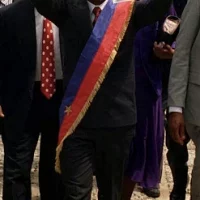Terrorism the world over poses a threat to the lives of Foreign Service Officers. Throughout the 1970s and 1980s terrorist groups threatened the safety of FSOs serving in South America. In Argentina, two such groups, the People’s Revolutionary Army (ERP) and Montoneros, resorted to armed resistance 1969-1970 in response to the regime of Juan Carlos… Read More "The Technology of Terror – South America in the 70s and 80s"
Crisis Management: Occupation of USIS in South Korea, 1985
On May 25, 1985, seventy-three South Korean students barged into the United States Information Services (USIS) library in Seoul and began a three-day occupation. The students’ primary demand was an apology from the U.S. Ambassador, Richard L. “Dixie” Walker, as the representative of the American government, for the United States’ alleged role and complicity in… Read More "Crisis Management: Occupation of USIS in South Korea, 1985"
The 1991 Coup Against Mikhail Gorbachev
In August 1991, hard-line members of the Communist Party of the Soviet Union (CPSU) who opposed President Mikhail Gorbachev’s reforms and decentralization of government powers tried to overthrow him. The short-lived coup attempt is considered pivotal in the rise of Boris Yeltsin and the eventual breakup of the USSR. The attempt took place at a… Read More "The 1991 Coup Against Mikhail Gorbachev"
Brass Tacks and Kashmir: India-Pakistan Military Crises in the 1980s
A crisis between India and Pakistan erupted between November 1986 and March 1987 after India launched the largest-ever military exercise in the subcontinent, called Operation Brass Tacks. The exercise took place in the desert area of Rajasthan, a few hundred miles from the Pakistani border, and included nine infantry, three mechanized, three armored and one… Read More "Brass Tacks and Kashmir: India-Pakistan Military Crises in the 1980s"
Negotiating the Limited Test Ban Treaty (LTBT)
Due to rising concern about radioactive fallout from increasingly big nuclear tests underwater, in space, in the atmosphere and underground, as well as concern over the burgeoning arms race between NATO and Warsaw Pact countries, the US, UK, and USSR decided to negotiate a test-ban treaty. These concerns became more pronounced after the United States… Read More "Negotiating the Limited Test Ban Treaty (LTBT)"
Chipping Away at Czechoslovak Communism: The Helsinki Final Act and Charter 77
The Solidarity Movement. Perestroika and Glasnost. The fall of the Berlin Wall. All of these movements, policies, or events had a tremendous influence on the dissolution of communism in Eastern Europe and the end of the Cold War. While not attributed the same attention and certainly less well known, many diplomats operating behind the Iron… Read More "Chipping Away at Czechoslovak Communism: The Helsinki Final Act and Charter 77"
Bombing North Vietnam into Accepting Our Concessions: Christmas Bombings, 1972
President Richard Nixon ordered plans for retaliatory bombings of North Vietnam after talks to end the war in Vietnam broke down December 13, 1972. Operation Linebacker II, otherwise known as the “Christmas Bombings,” began December 18 and lasted for two weeks. A total of 741 B-52 sorties were dispatched, dropping 20,000 tons of bombs on… Read More "Bombing North Vietnam into Accepting Our Concessions: Christmas Bombings, 1972"
Haiti has long been plagued by coups d’état and regime changes, leading to long-time political instability and weak governance. In this volatile political field, it was easy for a Haitian leader to assume dictatorial powers, as was the case with President François Duvalier, also known as “Papa Doc.” After becoming the President of Haiti in… Read More "The Overthrow of Haiti’s Aristide"
Establishing an Escape Network in Post-War Hungary
Throughout most of World War II, Hungary operated in conjunction with the Axis Powers and actively contributed to the Nazi war effort under the leadership of Miklós Horthy. While invading Soviet troops had pushed out the occupying German forces by April 1945, the newly established Russian presence quickly posed a precarious threat to Hungarian stability… Read More "Establishing an Escape Network in Post-War Hungary"
“How many people can you fit on a 747?”- Operations Sheba and Solomon
The Ethiopian Aliyah, as it is known in Israel, was the migration during the 1980’s of thousands of Ethiopian Jews [known in Amharic as Falashas; some consider the term pejorative] to Israel. The Israeli Defense Force (IDF) played a major role in the evacuation of the Ethiopian Jews as they came under increasing threat from… Read More "“How many people can you fit on a 747?”- Operations Sheba and Solomon"

